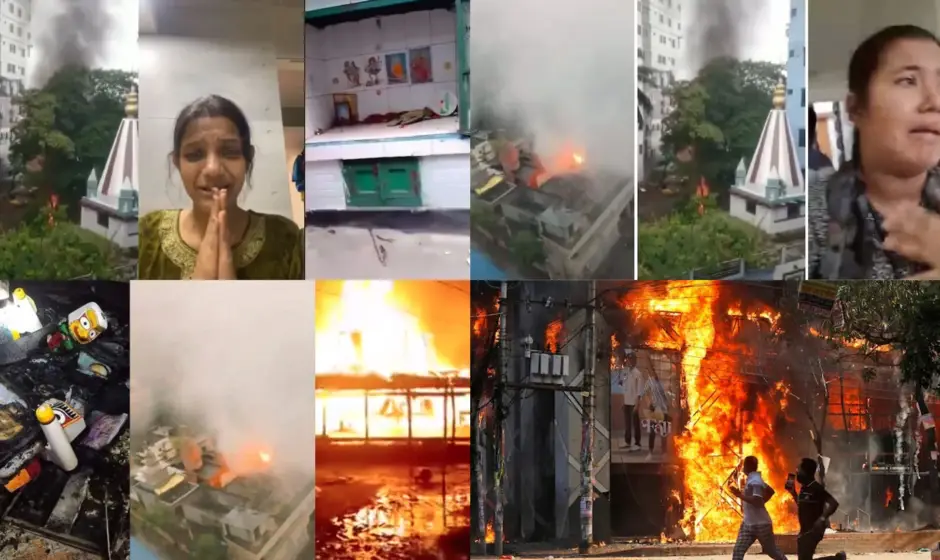Zafar Sobhan, ���The Print’ made false, tall claims about fair treatment to Hindus. Bangladesh President Yunus came close to stating the truth,
Are Hindus really not under threat from jihadists in Bangladesh? Are they safer than Muslims and other minorities in India?

Well, Zafar Sobhan in a write up has made vague but determined attempt to whitewash continued atrocities against Hindus with no letup in the genocidal campaign.
But, Sobhan falsely claimed that Hindus were safe in turbulent, unsettling and violence ridden Bangladesh ignoring the publicly available data, case studies and unhindered persecution.
‘The Print’ provided its columns to Zafar Sobhan for spreading these falsehoods like agenda-based international media organizations like Al Jazeera etc.
This response will methodically debunk Zafar’s fallacies and provide a true picture of minority conditions in Bangladesh. From rapes, violent attacks, forced resignation of Hindu officials to loot and occupation of their properties has become the norm while the likes of Zafar look the other way.
As per Bangladesh Bureau of Statistics, Hindu population in the country has dropped drastically to 8.5 per cent in 2011and down further in last 13 years from 13.5 per cent in 1974. This demographic shift is not merely result of migration for economic opportunities but deeply intertwined with systemic discrimination, land dispossession through Vested Property Act and constant incidents of targeted attacks on Hindu society.
By design and intent, Zafar seems to have downplayed incidences of violence against minorities in Bangladesh, implying that such incidents were isolated and do not reflect greater societal issues.
Centre for Integrated and Holistic Studies investigations uncover that Hindu temples, businesses and houses are frequently and widely attacked particularly during times of recent political turmoil.
These occurrences are not random acts of violence; they are frequently coordinated by extremist groups aiming to impose control or exploit political instability.
Data for June – August 2024 indicate an organized attempt to intimidate, harm and ultimately wipe out Hindu population in Bangladesh. The attacks were carried out in several areas, targeting vulnerable individuals and religious sites. Temples in Moulvi bazar, Chittagong and Sitakunda are a few known cases of desecration that highlighted coordinated campaign of genocide and eradication.
Zafar offered to paint the violent political movement that resulted in Sheikh Hasina’s departure as ‘democratic uprising free of Islamist influence’. This portrayal is inaccurate and ignores the complex realities of Bangladesh’s political scene.
Islamist Influence and Extremism
Emergence of extreme Islamist outfits such as Jamaat-e-Islami and Hefazat-e-Islam in Bangladesh’s political setting cannot be ignored. These organizations have documented history of campaigning for policies that oppress minorities and undermine the concept of secularism. Zafar’s denial of Islamist involvement in contemporary political movements is not supported by facts which demonstrates that these outfits have used political turmoil to promote their interests at the cost of minority oppression.
Political Transitions’ Impact on Minorities
In Bangladesh, it is a trend for minorities to become the targets of violent attacks during any political movements. An example of the kind of widespread violence that can result in deaths, serious injuries, significant property destruction, and vandalism of temples, was in 2021 during Durga Puja. These events demonstrate how vulnerable minorities are during times of political instability, contradicting Zafar’s assertion that minorities are safer in Bangladesh.
Over years, persecution and intentional attacks against the Hindu community in Bangladesh have had a profound and long-lasting effect. For instance, massive violence against Hindus erupted in 2013 when Jamaat-e-Islami leader Delwar Hossain Sayeedi was found convicted. Around 50 temples were attacked and more than 1,500 Hindu homes were demolished. This incident fits into a larger pattern in which elections and political upheaval are followed by violent attacks against Hindus.
Numerous instances occurred between 2013 and 2020, one of which was looting and demolition of 500 Hindu homes in Gopalpur village alone during the 2014 post-election riots. These acts demonstrate how this religious minority in Bangladesh is subjected to systematic and ongoing persecution.
Historical Background, Persecution and Displacement
It is critical to comprehend the historical background in order to evaluate current state of minority affairs in Bangladesh. The long-term patterns that have influenced lives of minorities in Bangladesh have not been sufficiently taken into account by Zafar Sobhan.
Periods of severe persecution are a defining feature of the history of minorities in Bangladesh, especially during and after the 1971 Bangladesh Liberation War. Deliberate persecution of Hindus throughout the conflict and ensuing appropriation of land under the Vested Property Act have left a lasting impact on the community, leading to their uprooting and economic marginalization.
During the time of struggle for Bangladesh Liberation, on March 25, 1971, the Pakistani military launched a horrific operation of genocide against Bengalis, notably on the Hindu community. Around three million individuals were killed in systematic atrocities during this genocide, which lasted until Bangladesh gained independence on December 16, 1971.
At least 200,000 women were raped, and some estimates put the figure as high as 400,000. Brutality such as the Burunga massacre of May 26, 1971, when 94 Hindus were brutally killed by the Pakistani military at Burunga High School, marked the darkest height of the genocide. Over 10 million Bengalis, mostly Hindus, were forced to flee to India as a result of extensive atrocities committed by the Pakistani army, which saw no distinction between Hindu, Bengali, and Indian identities.
In the blunt repercussions of the Babri structure demolition in India, Islamist groups in Bangladesh began a violent massacre against Bengali Hindus on December 7, 1992. The earliest target was the Dhakeshwari Temple in Dhaka, which was attacked and set on fire. Further targets were the Bholanath Giri Ashram, which was robbed, and the Hindu-owned jewelry stores in old Dhaka, which were destroyed. The following days saw more bloodshed when Islamist attackers in Cox’s Bazar District set fire to fourteen Hindu temples and demolished 51 Hindu houses in Ali Akbar Dale.
Five temples suffered significant damage, and villages in Chittagong District such as Fatikchari and Mireswari were nearly completely destroyed by fire. By the time the violence decreased in March 1993, innumerable Hindu houses and temples had been destroyed and many had died. These attacks were part of a larger pattern of violence and persecution against Hindus in Bangladesh, and the perpetrators were allies of the ruling Bangladesh Nationalist Party (BNP), known as Jamaat-e-Islami. Taslima Nasreen, a Bangladeshi novelist (living in exile in India) also described the attack on Dhakeshwari Temple in her book ‘Lajja’, highlighting the brutal acts of Islamists. For her work she was threatened by Fatwa and bounty for her death by a radical fundamentalist group, known as Council of Islamic Soldiers (CIS).
For Bangladeshi Hindus, attacks, rape, harassment and threats are not just words in the dictionary but these are daily realities for the minority community in the nation.
It is essential to understand the historical and socio political backgrounds of minorities in Bangladesh. The complex facts that shape these communities’ lives are not adequately conveyed by superficial comparisons. Recognising systemic problems, enhancing legal protections, and promoting an inclusive and tolerant society are all necessary to address the difficulties of minorities in Bangladesh. Despite its complexity, India’s role in the region is founded on its commitment to upholding human rights and stability as well as legitimate security concerns.
The problems with minority safety in South Asia must be understood and addressed in a more realistic and data-driven manner. Such an approach will help to foster more reflective and productive discourse on the best ways to safeguard the rights and welfare of minority communities in the region.
Zafar Sobhan should maintain journalistic principles of objectivity, integrity, and fair reporting. The public loses an important source of unbiased, transparent, and credible information when journalists start acting as representatives of extremist narratives. When the safety and rights of vulnerable populations are at risk, the press has a responsibility to report the facts with clarity and without bias.
(Author is a doctoral fellow at Amity University in Gwalior, content manager at Centre for Integrated and Holistic Studies, New Delhi)



